Slow Hand Stitched Pieced Art Textured Black and White
Oil and acrylic paintings these days are most oft created on canvas. Canvas replaced wood panels for painting during the Renaissance because stretching sail across wooden bars immune for larger paintings that were portable, because they were lighter and could exist rolled, as well as being a more stable surface with less warping and cracking than a wooden panel. The first artist canvases were made from loftier-quality Venetian hemp sailcloth and the word sail derives from cannabis (hemp) – canvas made from linen was introduced before long later and cotton is a more recent selection of fibre.
Whether y'all are stretching your own canvas or ownership ready-prepared stretched canvases or sail boards, there are many types of canvas fabrics to cull from. The characteristics yous require of your surface will determine which you choose. The weight of the fabric, the fabric it is made from and the surface preparation, in different combinations will each give a different painting experience and will affect the final appearance of your painting.
At Jackson's we stock a proficient multifariousness of sheet that should cover about artists' needs. You lot can get a huge range of sizes and surface characteristics in ready-to-paint stretched canvases, only unwrap them and go! Or you could add a final coating of a ground to it to customise your surface. At that place are sparse canvas panels and Ultralite boards which are keen for plein air painting considering they are lightweight and volition fit in near pochade boxes. If you wish to stretch your own canvas we take forty variations of canvas past the metre or past the 10-metre roll.
Many artists endeavour painting on dissimilar canvases, primers and grounds until they find the surface that works all-time for how they paint. The surface qualities can profoundly touch on some artists' painting, fifty-fifty more and so for techniques like staining in oils or acrylics. You tin compare some of the canvases that Jackson's stock by ordering sample pieces of the Claessens Linen or the Claessens Linen sample volume or the Belle Arti sample book.
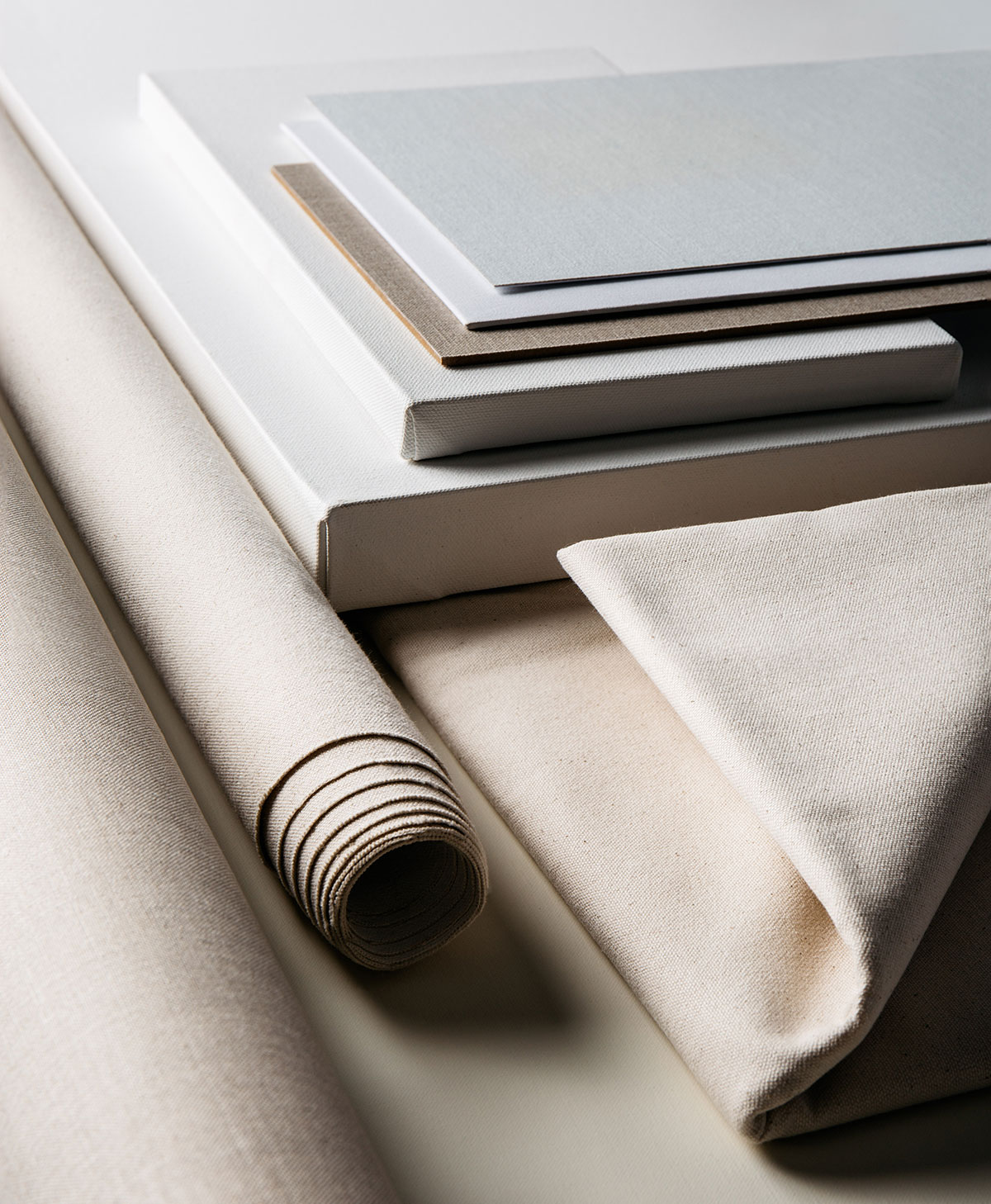
Hither are some things to consider when choosing which sail to paint on:
(click on the images for a larger view)
Fabric
There are two major fibre types used to make canvass: cotton and linen (flax). Some speciality fibres such every bit hemp and jute are as well used for canvas – we do jute, and although it is a dissimilar fibre information technology is usually considered an actress-rough linen because information technology is very like.
Cotton
Cotton is economical but not as strong equally linen and it hasn't been time-tested like the linen used by the old masters. Cotton wool is easy to stretch and stays tight on the stretcher bars. Linen is made from flax and is stronger considering information technology has longer fibres which means that it is less likely to tear at the staple line or at the abrupt exterior corner of the stretcher bar. It also ways that you can utilise finer and thinner linen for the aforementioned strength every bit heavier cottons. The stiffness of linen means it is harder to pull when stretching and you need to take care to keep even tension across the canvas or it tin ripple along the edges later on. Some artists choose to buy ready-prepared linen canvases because linen has a reputation for existence much more difficult to stretch than cotton. Unprimed cotton is usually a cream colour and unprimed linen is usually a chocolate-brown because it is unbleached, but we have some primed Italian cotton that has a coating on the reverse that makes information technology darker on the back. Cotton Duck Canvas has more tightly woven threads than plain cotton sail – the term 'duck' comes from the Dutch discussion for cloth, doek.
We stock two types of cotton by the metre: Cotton wool Duck is the most common canvas in the earth, information technology has many uses exterior of fine art (canvas bags and and then on), it usually has a noticeable weave and is quite thick. Nosotros stock it in three weights. Because of its low cost information technology is our most popular canvas sold by the metre (and the roll) and for our bespoke canvases – the 12oz primed, to be exact. Our Italian Poly-cotton is an artist's sheet, it is made for our industry so it has a tighter weave, a finer thread and an overall smoother surface, fifty-fifty the 'medium' texture Italian cotton is effectively than the cotton duck we stock. At that place is also a super fine texture called No-Grain. The addition of polyester means the material volition not 'relax' as much every bit all cotton and become loose over time.

Cotton fiber canvas
From the left:
Jackson'south eight oz, 10 oz (primed & unprimed), and 12 oz (primed & unprimed).
Then Belle Arti 586. 575, 564, 576.
- Cotton Canvass Boards
- Cotton Stretched Canvases
- Cotton fiber Canvas by the metre
- All formats of cotton sail at Jackson's
Linen
Linen is more expensive than cotton wool, partly considering cotton wool canvas is much more common and at that place are many not-art uses for it, and then the lower toll is a result of the market place. There is professional quality creative person cotton canvas as well which is more expensive because it has a much smaller market demand. Linen is also more than costly than cotton because it takes many more steps to process the flax fibres and considering its inelasticity makes it harder to weave into fabric.
At Jackson's we stock linen by the metre from iii manufacturers. The French linen canvas from Artfix is made of smoother, more tightly spun yarn than the Italian linen from Belle Arti, and also has a more regular, tighter weave and is really strong. The Belgian linen from Claessens is between the ii. Because the famous Artfix company uses the highest grade of flax and has amazing quality control information technology is a superb linen. If you paint, scrape, repaint, scratch back, repaint, impasto, scumble glaze, and generally are hard on your surfaces then the French linen is a great choice every bit information technology will survive the rough handling. Because it is then tight information technology tin be a task to stretch it, though and it is our highest priced canvas as well. Claessens is located in the middle of the Flax Commune in Belgium. Their linen is made using small scale production and longstanding traditional sizing and priming methods. They employ the primers by hand with a palette knife. The Italian is made with a fleck coarser thread and more irregular weave but is a very skillful quality and nosotros are lucky to have gotten such a skilful price on information technology, information technology is lower priced than it should be for the quality. It is too easier to stretch than the French linen. Nosotros too stock jute for a coarse 3D texture and at a low toll for its thickness.
In addition to the great strength of linen and the fantastic surface information technology gives for painting, linen has enshroud among art collectors and and so artists will usually mention in their materials list -that it was specifically linen they painted on. Likewise there is something romantic most painting in oils made with linseed oil on a linen canvas – both being made from the flax plant.
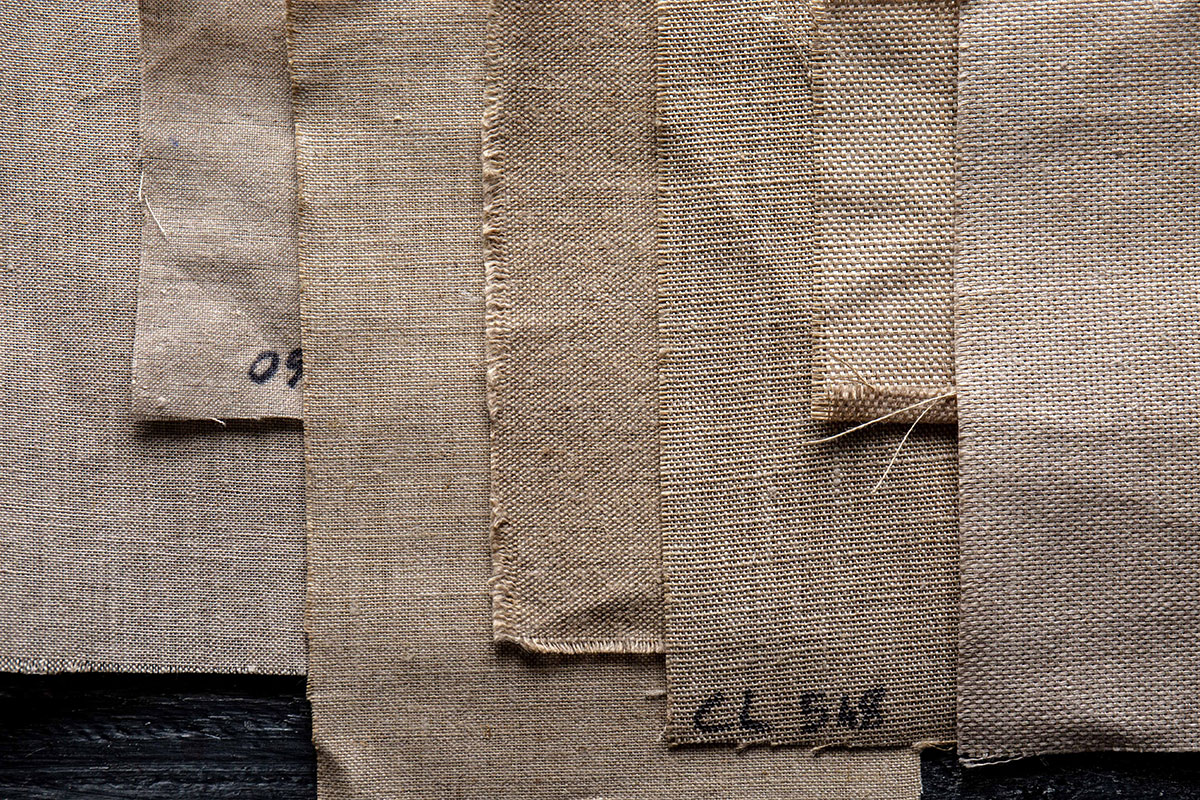
Unprimed linens
From left – finest to roughest: 549, 60, 596, 40, 548, xc, 581.
- Linen Canvas Boards
- Linen Stretched Canvases
- Linen Canvass by the metre
- All formats of linen canvas at Jackson'southward
Weave
In improver to choosing the fibre blazon you as well need to consider the weight and the texture of the weave. Similarly to paper, sheet is measured in grams per square meter (gsm) or ounces per foursquare yard (oz). If the linen has a heavy weight then one or both of the following is true: it is a thick, tough yarn and/or information technology is tightly woven. Lightweight linens have an open weave and by and large a fine yarn, they are easier to stretch and are more responsive to tightening procedures. The lighter weight canvases are ordinarily used by artists who draw and/or take a low-cal impact in their work, but even some impasto painters can use them as their paint skims over the air holes.
A fine canvas has minimal texture and can be most shine, while a rough canvas has a very pronounced weave. The selection of no grain, extra-fine, fine, medium, rough and extra-rough texture in a canvas affects the feel of painting and the last advent. Practise you want to see the filigree-similar weave, to have your brush skip over the bumps to leave bits of white to sparkle, or to build up layers of paint on the weave high points; or practise you want a surface where the sail is not a noticeable feature? Do you desire a texture that thick paint can grab onto or a smoother, slicker surface for sparse paint to glide over? A smooth texture is oftentimes important to portrait painters as a coarser texture can distort the appearance of skin, and so extra-fine linen canvas is sometimes even called Portrait Linen. The 'No Grain' texture is well-nigh equally smooth as paper and is also great for portraits.
The terms 'super fine', 'actress fine', 'fine', 'medium' and 'rough' refer to the texture of the weave not the weight. Texture is not necessarily a guide to the weight. Yous can have a lightweight canvas with a rough or medium texture or a heavier weight canvas with an extra-fine texture. Our 574 Italian universal primed linen is both lightweight and then fine that it feels like a sheet of paper, but considering it is linen it is potent enough to stretch tightly. Some artists particularly dearest the 574 canvas because it can accept watercolour and inks. Our 568 universal primed Italian linen is stiff and heavy enough for large scale work, has enough requite to be able to stretch nicely, has a tight weave then tin be used for both glazing and impasto work and anybody says it is just plain beautiful.

7 linen canvases with light behind to testify the weave.
From left – finest to roughest: 549, lx, 596, xl, 548, xc, 581.
- Extra fine canvas in all formats
- Fine canvas in all formats
- Medium sheet in all formats
- Rough sail in all formats
Weight
The heavier the weight the more than tension the canvass fabric tin accept without trigger-happy, and so for very large stretched canvases you might wish to choose a heavier canvas. Weight is how much material in that location is per area so it is determined by both thickness of the thread used to weave and how tightly it is woven. A coarse/rough canvas tin can be loosely woven so it could be lighter weight than a fine canvas that is tightly woven. But commonly, a thick thread makes a heavy canvas and a thin thread makes a calorie-free canvas.
Unprimed sail can be considered light-weight at about 5 oz (140 one thousand); medium-weight at nigh 8 oz (230 k); heavy-weight at well-nigh 10 oz (280 g) or more than. When the canvas is primed the weight listed includes primer then it can be hard to compare the weight of the actual canvas as some have a much thicker layer of primer than others. When we accept the information, we list the canvass weight on the Jackson's website both before and later priming.
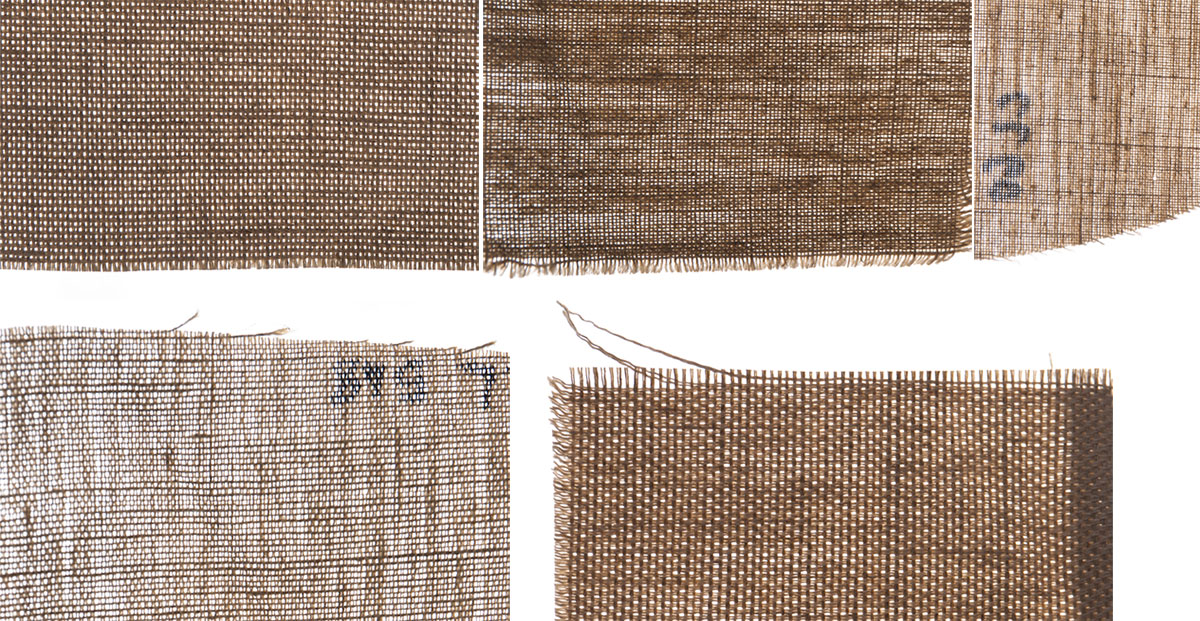
Shown is a variety of linen weaves – the looser ones fray more at the edge – these would exist more lightweight than tightly woven sheet using the same size thread.
- Low-cal-weight sail past the metre
- Medium-weight canvass by the metre
- Heavy-weight canvas by the metre
Make
Jackson's stocks iv brands of creative person sail bachelor by the metre: Artfix (French linen), Claessens (Belgian linen), Belle Arti (Italian linen and cotton wool), Jackson's (Indian cotton wool). These highest quality canvases are besides used for our Bespoke stretched canvases, our professional person-form ready-made stretched canvases and our Handmade Linen Boards.
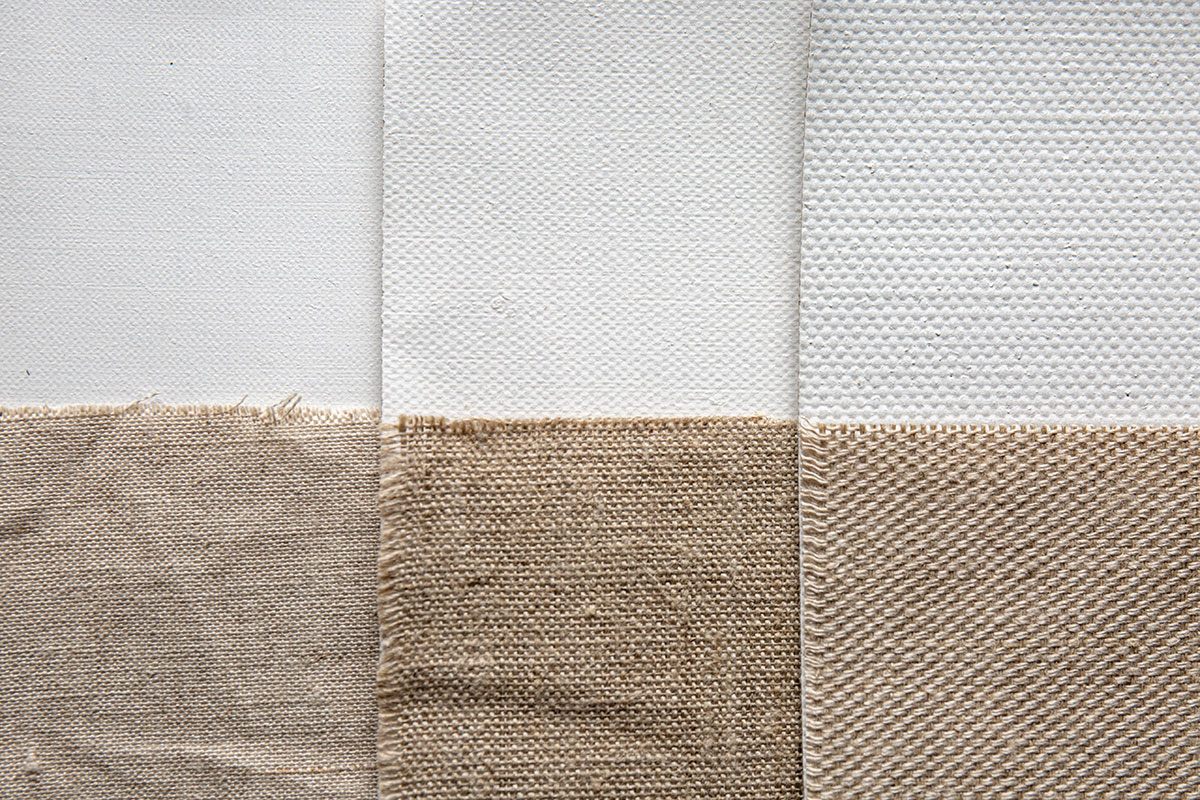
vi Artfix Linens – primed and unprimed.
From the left: Extra fine, fine and medium.
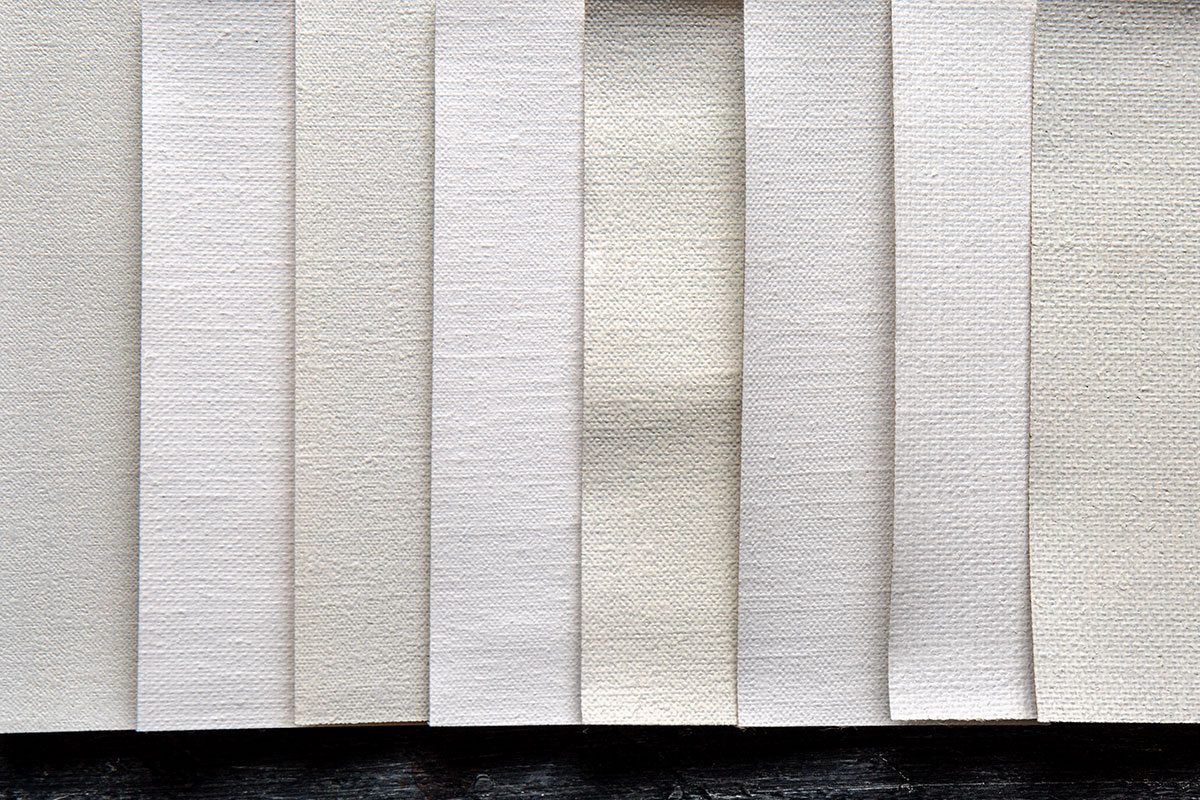
8 Claessens linens
From the left from Very Fine to Heavy.
From the left xiii, 109, 706, 112, 66, 166, 170, lxx.
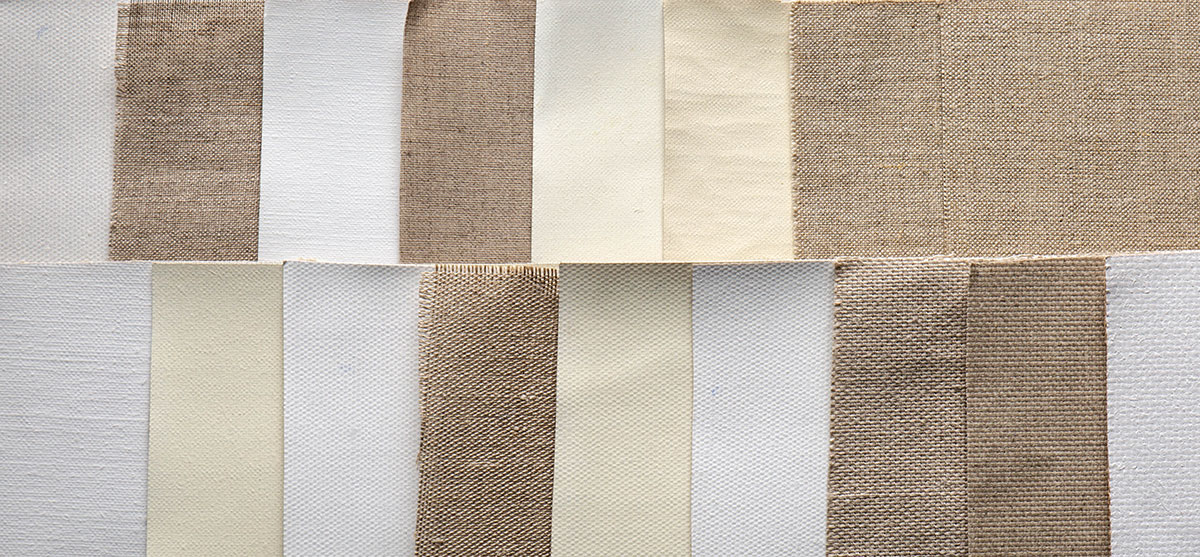
17 Belle Arti linen canvases from Finest to Jute.
From the left – top row: 511, 549, 574, 649, 540, 007, 596, 696.
From the left – bottom row: 535, 537, 533, 548, 536, 568, 581, 681, 565.

Jackson'south Indian Cotton sail.
From the left viii oz primed, x oz (primed and unprimed), 12 oz (primed and unprimed).
We also do a broad selection of ready-fabricated stretched canvases and boards that use other artist-grade and educatee-grade canvas.
Rolls of canvas
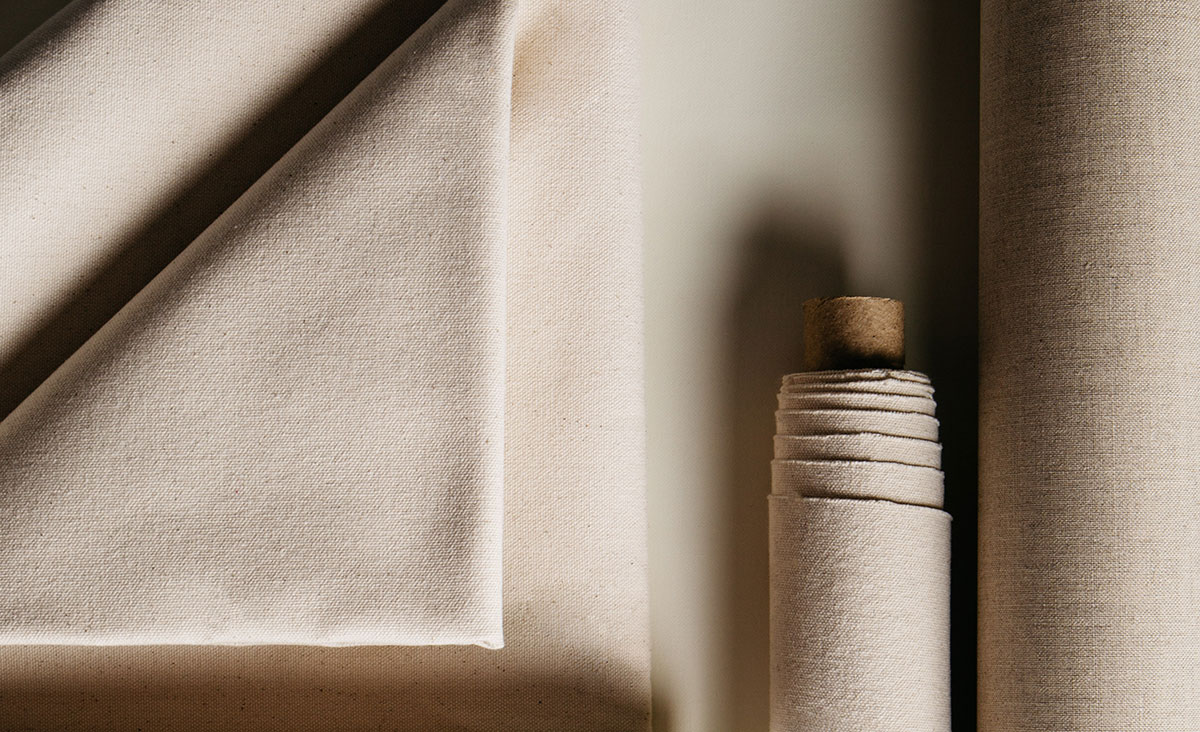
Sheet comes in rolls which are 210 cm or 183 cm wide. A full roll is 10m long. Y'all can purchase the total coil or metres cut off the scroll (these must be whole metres, non fractional). We also offer one-half-width rolls which are easier to send and to shop in the studio if you are not making very large canvases. Folding primed canvas tin crack the primer so it must e'er be sent and stored on a scroll, even if it is just one metre cut off the scroll. Simply unprimed canvas can exist removed from the roll and folded which can relieve on shipping charges equally a coil is quite long and attracts over-sized shipping charges.
When measuring to purchase canvas to stretch your own, be certain to business relationship for the amount required to go up the sides or around to the back of your bars (whichever depth you choose) plus the additional amount you will need to grab and pull with your pliers which yous will later trim away or fold nether. Besides account for the unlike widths of some of the rolls of canvas.
- Cotton sail by the metre, 5m or 10m – on a curl or folded (non all canvases are available in all formats)
- Linen canvass past the metre, 5m or 10m – on a roll or folded (not all canvases are available in all formats)
Stretched across bars or mounted on a panel
Depending on their painting style some artists similar the bounciness of a canvas stretched beyond bars, others prefer the lack of movement of sheet glued to a panel (also chosen a lath). The rigid support tin can be made of solid wood, plywood, MDF, heavy menu, thin stiff plasticised card, or Gatorboard (plastic impregnated cream lath). The canvas can be cutting off shear with the edge of the back up or it can be wrapped around to the back and glued down.
Read more about mounting sheet to a panel in this blog article Making a Sail Painting Panel.
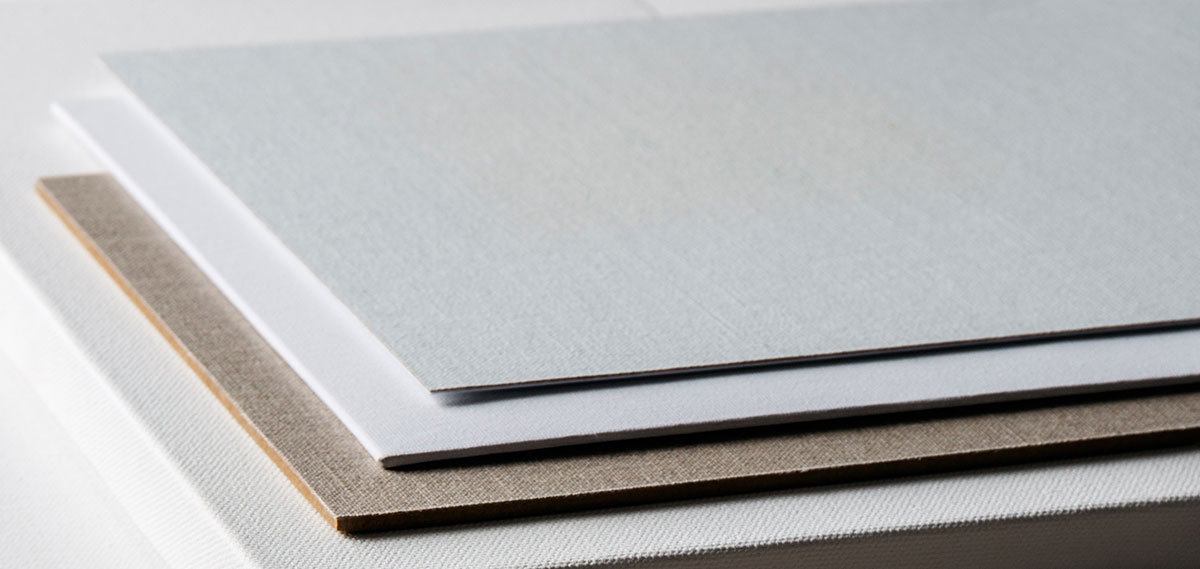
Sizing and Priming with a Ground
The final thing to consider would be the primer on your canvass. Creating a stable structure before you brainstorm adding paint will assistance to ensure that the painting will remain in the best condition for the longest time. You tin can choose from a variety of primed surfaces or go with unprimed and treat the surface yourself.
Canvas comes either uncoated or with a primer coating. Jackson's stock unprimed, universal primed, oil-primed, gesso-primed and gum-sized sail by the curl and on many of our panels and professional person-quality stretched canvases. Non all types of blanket are available on all types of sail or in all types of format (stretched, panel or by the metre). The priming can be sprayed on in one to 7 coats with less expensive educatee-grade canvases beingness one coat and virtually artist-grade sheet being two to four coats. Claessens apply their primer by hand with a palette knife to brand sure it is scraped into the weave for the all-time adhesion and protection of the canvas, and so for the oil primed linen they follow up with a final coat of primer applied with a roller.
You can add your own boosted coating on tiptop of a set up-made universal-primed sail. You may wish to:
- Make the surface more than white.
- Color the surface merely keep a gesso texture by calculation a tinted ground, a mid-tone coloured ground or a black ground.
- Make the surface absorbent enough for watercolour painting by applying a few coats of Watercolour Ground.
- Add an oil ground for the unique texture that provides.
Sizing
You can paint on unprimed sail directly with acrylics only if y'all are painting in oils and y'all want the painting to last, you will need to seal the surface. Oil paint dries past oxidation, slowly arresting oxygen from the air. If sail or paper is in contact with the oil in oil paint or oil primer information technology slowly corrodes the canvas fibre. To prevent this canvas needs to be sealed from oil penetration. This sealing process is chosen 'sizing' and the sealant is called 'size' – so 'to size' your canvass means to seal information technology. Size is either hide gum (rabbit pare gum RSG) or acrylic polymer. The secondary purpose of size is to stiffen the fabric so information technology has less bounce. RSG comes every bit pellets that are soaked to soften them and and so gently warmed to use as a size or part of the recipe of genuine gesso. Warming RSG is not a smelly process, the reputation for smelliness comes from leftover liquid glue rotting in a corner of the studio days later. It doesn't rot after information technology is stale on the sheet. If you practise decide to utilise it be aware that if you do either of these two things the mucilage will be less effective: over-estrus information technology or employ it after it has rotted from sitting out as a liquid for days. Recent studies have shown that RSG is problematic every bit a size because it continuously absorbs moisture from the air, causing information technology to smashing and then when the air is dry information technology shrinks. Over time, this constant change in the surface under the brittle layer of oil pigment causes the oil paint to crevice. RSG is now understood to exist the main cistron of cracking in old oil paintings. And so for a more than lasting solution many artists at present utilise a fluid acrylic polymer or a PVA size to seal the sheet and GAC 400 can be used to stiffen the canvas.
A wide range of traditional and mod sheet size (sealant) tin can be found at Jackson'south.
Glue-sized canvas
Purchasing canvas that is already glue-sized saves a footstep when you are stretching canvas and it also makes the linen easier to stretch evenly as the added stiffness helps information technology keep the weave shape.
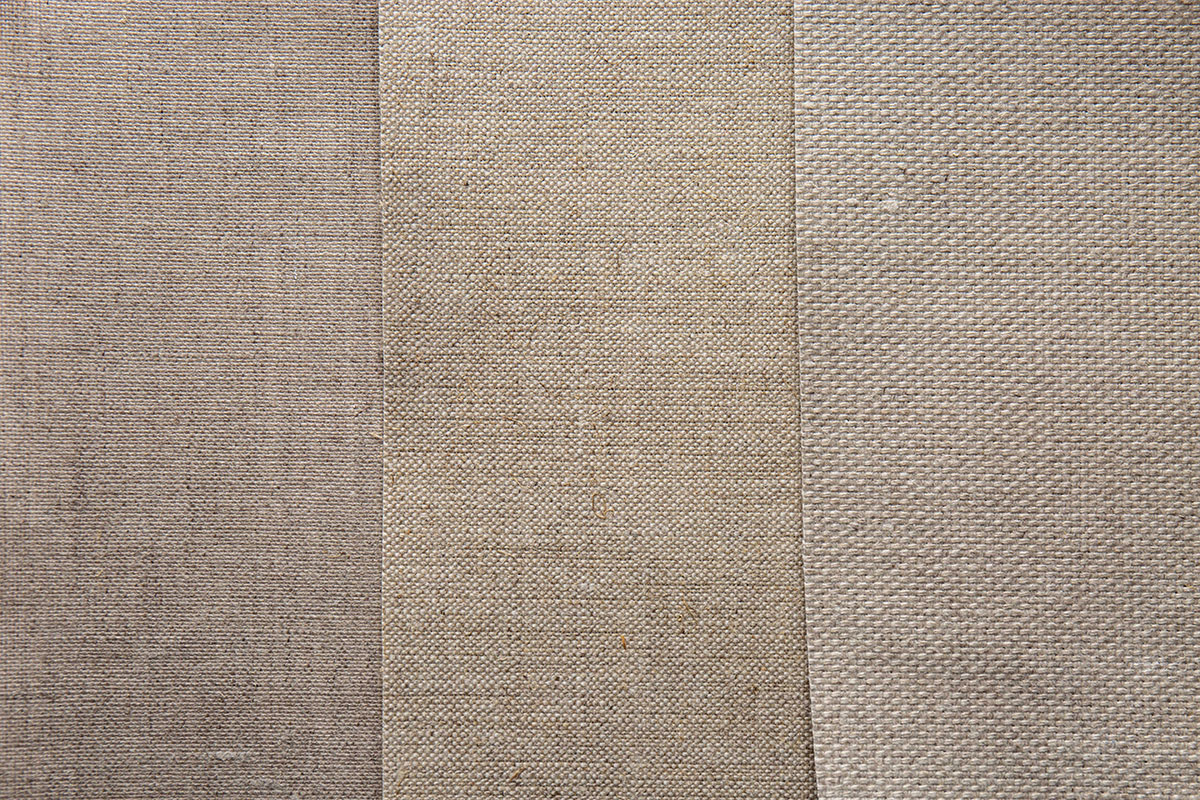
Belle Arti glue sized linen canvas.
From left: extra fine, fine and rough.
Priming
The type of ground affects many things about the painting. The corporeality of tooth affects how well the pigment adheres and how much brush-drag you lot feel every bit you lot paint. The amount of absorbency affects the glossiness and brightness of oil color equally the oil is absorbed by the ground and if pigment is as well sucked in, the colour will be macerated. An oil basis is oftentimes less absorbent and quite smooth for a silky painting experience where the colours sit proud and vibrant. Later you take sized the sheet yous tin utilise one or more coats of a footing, the surface you will employ paint to that gives the correct amount of molar, too called providing a 'key' for the pigment to stick to. Priming your own canvas will permit y'all to actually piece of work the starting time coat into the weave (to create a good bulwark against oil paint penetration) and then to make the additional coats as smoothen or textured equally you wish. Unless you lot sand the dried primer for a actually smooth surface, in that location will probably be some brush mark texture.
Acrylic primer
Acrylic primer usually acts equally both size and primer. If you are using acrylic primer to provide a barrier to oil paint bank check if you demand another coat past holding the sheet upwardly to the light – if pivot holes of low-cal show through then you need more primer to seal it. When a canvas says information technology has Universal Primer that ways it is an acrylic primer than can be used with acrylic or oil pigment. If it is labelled equally acrylic 'gesso' this sometimes means it is more than absorptive than acrylic 'primer', though this varies a lot my manufacturer. To apply it you usually thin with water for the first glaze and scrub it into the weave or scrape information technology on with a palette knife. Then get a bit thicker for each following coat. Applying primer too thickly may result in swell when it dries as information technology volition shrink a lot. So building up the surface with many lite coats is better than one heavy one. A light coat is often dry plenty in thirty minutes to apply the next ane so a batch can easily be washed in one day. For the smoothest surface many artists sand betwixt coats.
Oil primer
An oil-primed canvas can only take oil paints. Although oil paint can be applied to an acrylic gesso primer, acrylic paint volition not permanently adhere to an oil-primed canvass and volition eventually peel off. Oil primer contains oil paint and and so you must apply a sizing of some sort first as a barrier. Information technology ordinarily need a few weeks to cure as well, so the surface is properly ready to paint on.
Genuine gesso
Genuine gesso is a very absorbent surface, which is what is needed for painting with egg tempera or encaustic. It is made in the studio and applied warm as it contains RSG. It will crack on flexible surfaces and should exist used merely on rigid surfaces, usually wooden panels. We now have a 'gesso manus-primed' canvass available in an Italian linen that has quite a delicate dry surface that is very absorbent nonetheless information technology doesn't easily fissure (though it could if handled badly).
Surface texture
Some painters similar the look of the texture of the weave showing through so they do non add together many coats of primer, only enough to seal the canvas and requite a white basis. Renaissance masters preferred a super-smooth surface created by applying many coats of primer, sanding betwixt each, until the weave was completely obscured.
Articulate primer
Some artists require a clear primer considering they wish to utilise the colour and texture of the canvas as an integral part of the painting. If y'all similar the colour of the canvas and don't want a white basis you can prime number the sheet with a fluid acrylic medium like Matt Medium or a 'clear acrylic gesso' to soak into the fibres and fill the weave holes. It normally takes a few coats.
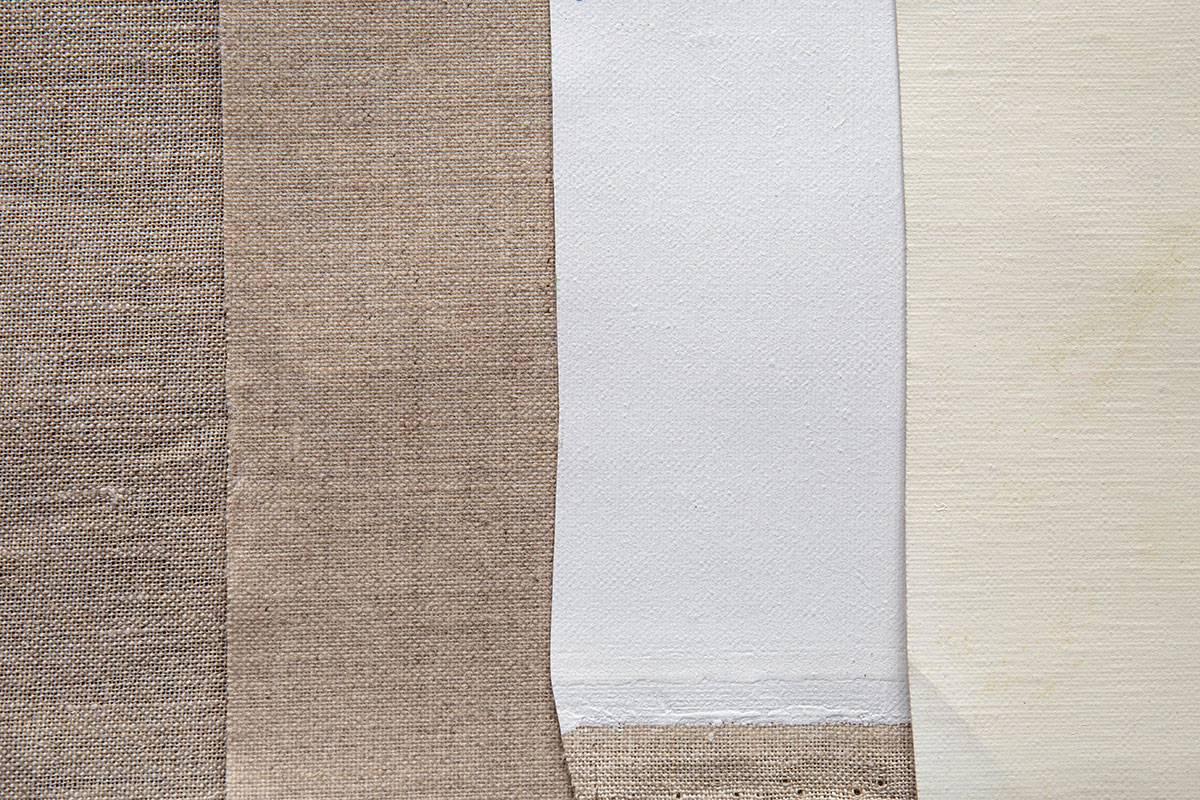
Belle Arti Extra Fine grain linen.
From left: unprimed, glue sized, universal primed, oil primed.
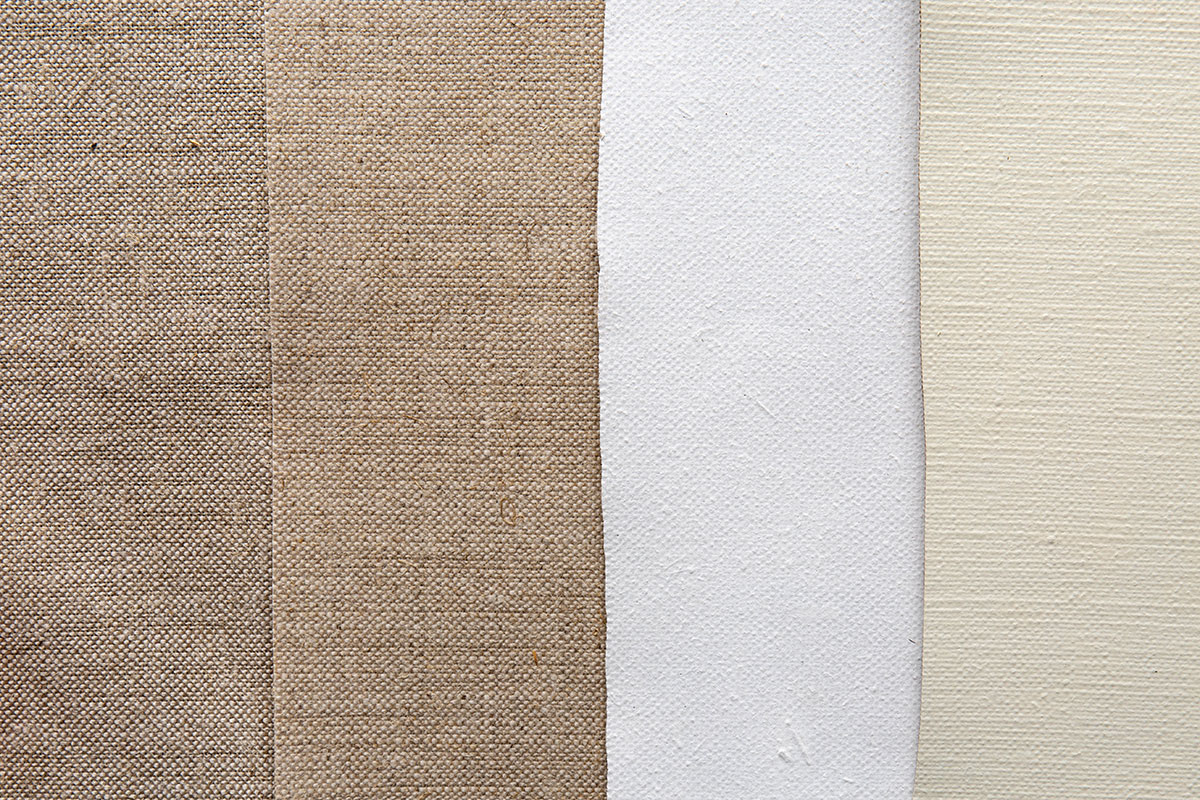
Belle Arti fine grain linen.
From left: unprimed, glue sized, universal primed, oil primed.
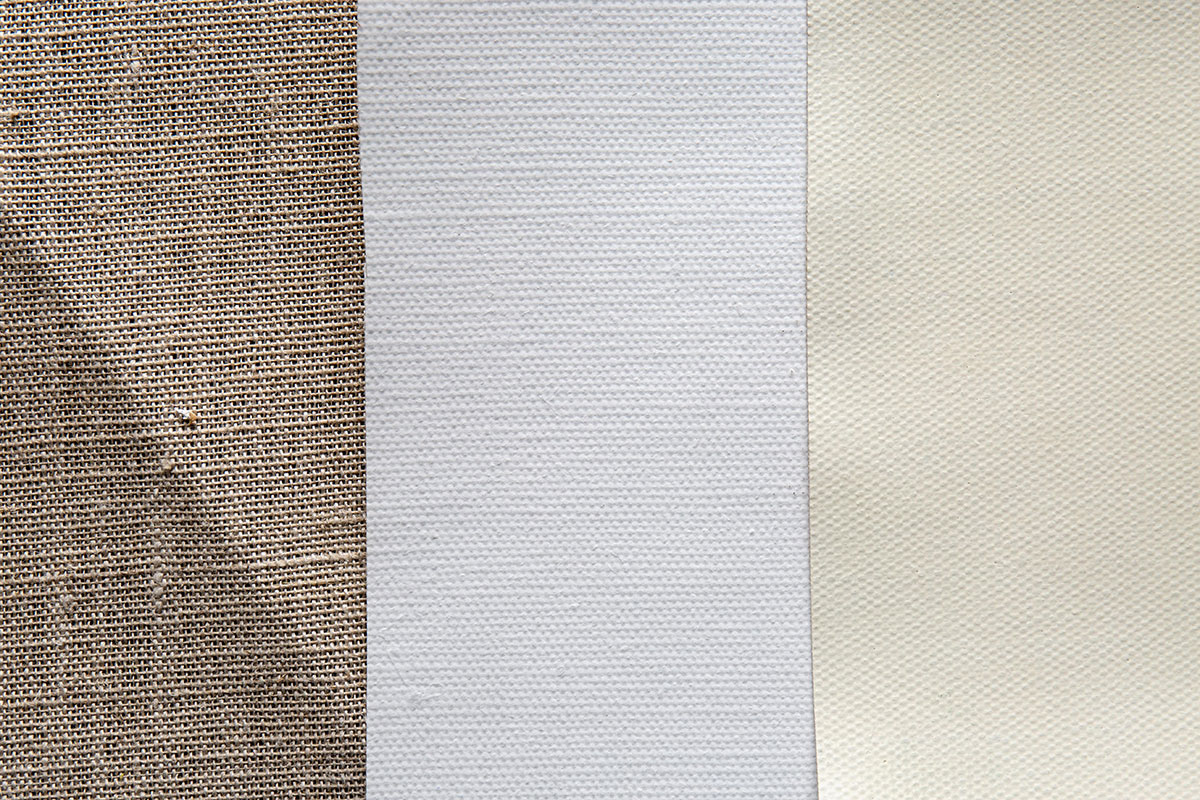
Belle Arti medium grain linen.
From left: unprimed, universal primed, oil primed.
Canvass at Jackson's Art
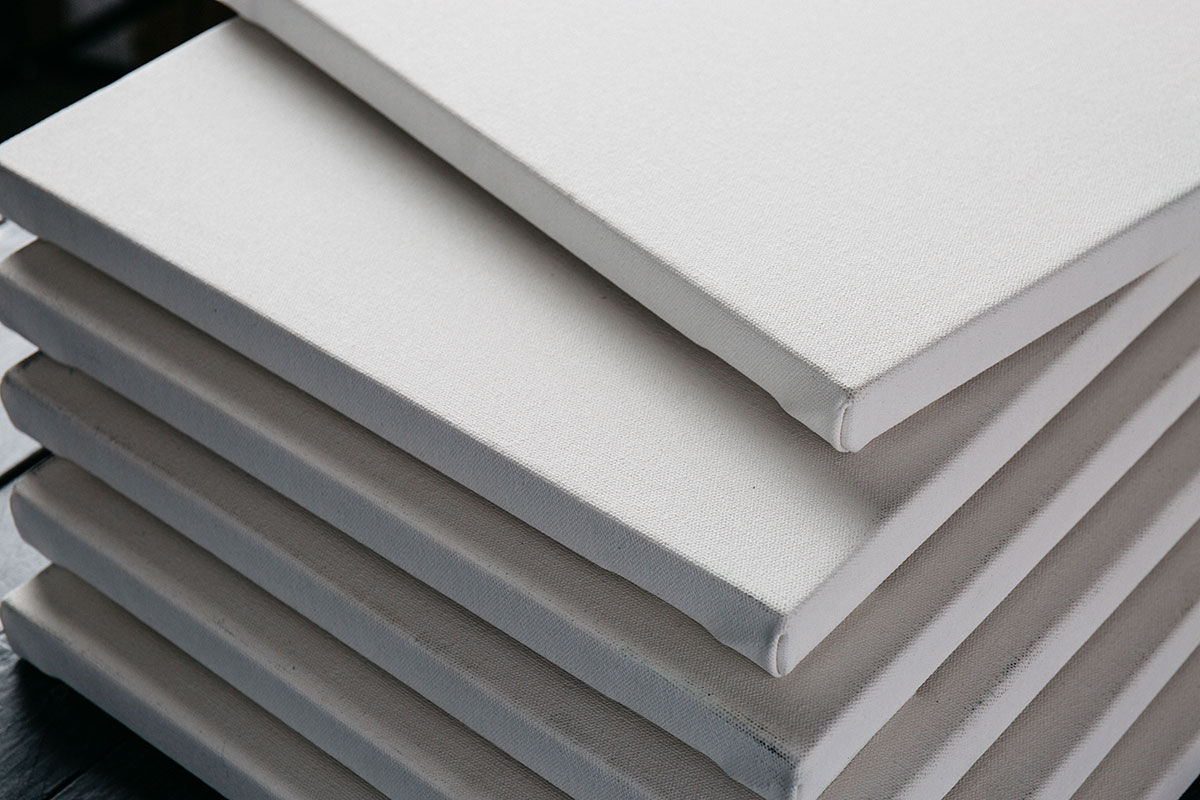
The canvases in this article are available at jacksonsart.com in a variety of formats – ready stretched, mounted on panel and past the metre – set up to be delivered to your studio.
You can compare some of the canvases that Jackson's stock by ordering sample pieces of the Claessens Linen or the Claessens Linen sample volume or the Belle Arti sample book. With the Belle Arti book you become refunded the buy the toll of the book when you purchase one of the canvases. Since we don't take a mode of letting the website know that you have previously ordered the sample book yous will need to society the canvas on the phone and let the operator know you have purchased the volume.
- Stretched Canvas
- Bespoke Stretched Sheet
- DIY Canvas Stretching – Stretcher Bars
- DIY Sheet Stretching – Canvass by the metre
Postage stamp on orders shipped standard to mainland UK addresses is free for orders of £39.
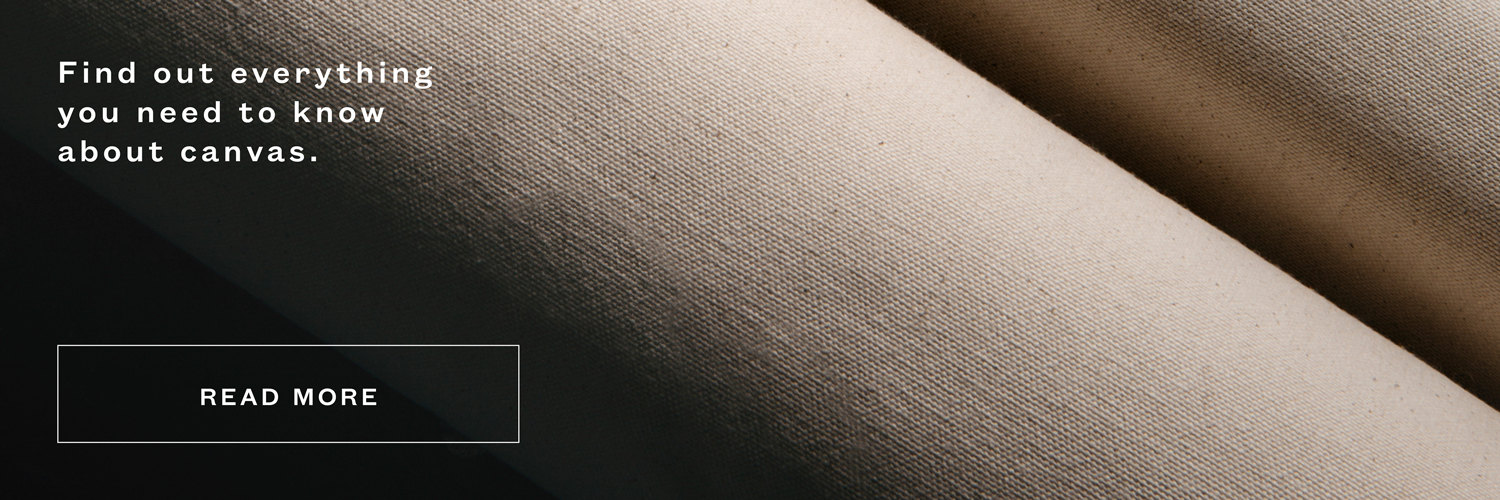
Source: https://www.jacksonsart.com/blog/2018/09/13/choosing-the-right-canvas-for-your-painting/
0 Response to "Slow Hand Stitched Pieced Art Textured Black and White"
Post a Comment